Education for Sustainable Development: Evolution and Perspectives: A Bibliometric Review of Research, 1992–2018
Abstract
1. Introduction
2. Literature Review of Bibliometric Studies on ESD
3. Methodology
- Establishing a descriptive structure such as the volume, distribution (based on the research field) and dynamics of ESD publications between 1992 and 2018, as well as the authors with the most publications, the scientific disciplines with most published results, etc.
- Determining the impact scientific publications have on generating new knowledge. For instance, classical citations, the main actors (authors, institutions, countries, etc.), the papers that have contributed the most to the progress of scientific knowledge, the most influential journals for publishing the findings of studies, etc.
- Tracing collaboration patterns (e.g., the degree of collaboration among authors, countries, or institutions).
- Identifying key research areas and emerging trends (e.g., the major research areas, the most active areas, critical transitions in the development of the field, domains that were not explored by previous research, etc.).
3.1. Methods and Tools
3.2. Sources and Data Collection
4. Data Analysis and Results
4.1. Content Analysis
4.1.1. Document Types
4.1.2. Papers in Different Subfields/Categories
4.1.3. The Annual Trends of ESD Related Publications
4.1.4. Authorship
4.1.5. Countries/Regional Distributions
4.1.6. The Distribution of Institutes on ESD
4.1.7. The Distribution of Published Journals on ESD Study
4.2. Citation and Co-Citation Analysis
4.2.1. Citation and H-Index Analysis
4.2.2. Co-Citation Analysis
4.2.3. Co-Authorship and Collaboration Patterns
4.2.4. Keywords Analysis
5. Discussions
5.1. Content Analysis
- (a)
- From 1992 to 2004, the initial stage, with only 37 records in total. The first article in the database was issued in 1996, compared to 1998, found by Hallinger and Chatpinyakoop [54]. Until 2005, there was a slight increase in the number of publications. For roughly the same period (1990–2005), Wright and Pullen [1] reported that the number of articles on ESD increased from 64 in 1990 to 162 in 2004, but this growth was nonlinear.
- (b)
- Between 2005 and 2014, we are in a steady rise stage, the total records being 703. Figure 2 illustrates that, starting with 2005, the number of publications tended towards a dynamic growth and peaked in 2014, when 134 articles were published. According to [1] (p. 80), “while it is beyond the scope of bibliometry to investigate the causes of the observed peaks and increase, it is conceivable that they correspond with various international efforts to promote ESD.” Indeed, this stage coincides with the UN Decade on Education for Sustainable Development. The articles written in this period were, in general, research papers concerned with integrating sustainable development principles and practices in all aspects of education. The topics mirrored the aim of the decade to encourage change in knowledge, values, and attitudes, conducive to a more sustainable and fair society for all.Starting with this period as well and continuing into the following years, ESD sparked the interest of both researchers and mass-media. A series of research and awareness campaigns was initiated, regarding the need for EfS and SD.
- (c)
- From 2015 to the present, we are talking about the stage of high growth. There were 1073 papers published in this period, with a peak (291) in 2017. Basically, since the formal concept of ESD emerged internationally, there has been a steady rise in the number of publications, which proves that ESD is an active area of research. According to [1], a simple explanation for this growth may be the fact that in 2015, during the UN summit organized in New York, Agenda 2030 for sustainable development was drafted and adopted by all member states, together with its 17 SDGs. As a result, papers published after 2015 focused more on the role of education for the achievement of sustainable development, especially from the perspective of SDG4: Quality Education for All.
5.2. Citation and Co-Citation Analysis
5.3. Co-Authorship Analysis
5.4. Co-Occurrence Analysis
5.5. Limits and Suggestions for Further Research
- Firstly, our study was based on a sample of documents from WoS. There are other databases that index papers on ESD that should be explored. As we have seen in Table 3, Scopus and Google Scholar offer for the most cited authors more documents than WoS. Tăbăcaru [104] reported that at the beginning of the year 2019, Scopus had 31% more indexed journals than WoS. In a recent study, Martin et al. [37] asserted that Google Scholar will be a better source than WoS or Scopus in terms of comprehensive coverage and finding significant citations. However, scholars might consider conducting bibliometric analyses using other databases, maybe even making comparisons between them [85].On the other hand, due to terminological innovations, variations, or linguistic confusion, articles that are relevant to ESD might exist, even though they have not been covered by this bibliometric study. Consequently, we believe further bibliometric investigations are necessary, so that we make sure a complete (as far as possible) dataset is obtained and then analyzed. In order to avoid duplicates or names with diacritics, apostrophes or ligatures, Thesaurus in VosViewer could be used.
- Secondly, it is well known that WoS includes, almost exclusively, documents published in English. Although the WoS Core Collection also comprises non-English journals or literature (with the non-English titles translated into English), the number of publications in other languages is much lower. In their study about promoting sustainability in HE in Portuguese speaking countries, Bizerril et al. [105] searched the SciELO (Scientific Electronic Library Online) database as well, showing that the number of papers on the topic was much bigger in Portuguese than in English provided by WoS. Thus, an analysis on non-English language databases would be interesting to do.Furthermore, as our results showed, the non-anglophone countries and cultures have different perspectives on ESD (with the notable impact of Chinese literature). More and more often, documents written in vernacular languages (which usually address locally or regionally relevant topics) cite non-English literature. This has a direct influence on the citation coverage of documents.
- Thirdly, by analyzing the WoS dataset, for the period of 1992–2018, we gained a general view of the ESD field, because the impact of documents, authors, and journals changes over time. Although the citation indicator is not exhaustive, it is quite objective and is widely used to assess the performance of scientific research. However, this indicator only calculates citations of published papers; informal communication, the exchange of ideas, and their contribution to the configuration of a scientific work are not taken into consideration.
- Another limitation refers to the level of interest generated by an author’s work. Despite the fact that in WoS, we have the ”Usage counts” function, in this study, we did not consider the degree of visualization and the number of downloads in a bibliographic management tool; nor did we use alternative or complementary metrics for disseminating and tracking research. For instance, influence on social media (tweets about an article, journals comments, research blogs, Facebook posts, Wikipedia pages etc.) can be tracked by tools such as Altmetric.We did not include the type of papers in the set, either. Are they literature review, essays, conceptual papers, theoretical, or empirical studies? This is more a shortcoming of the method than a limitation of our study, but future systematic and qualitative reviews might be able to incorporate these aspects, as well.
- As we have seen, there are emerging research trends or certain sub-fields that are less researched (e.g., IK) and are awaiting contributions (e.g., the importance of new technologies and applications in ESD, like serious games, artificial intelligence, Internet of Things, or blockchain). Thus, we could add to further studies more detailed bibliometric analyses of some of the clusters and themes/topics detected in this work.
- Finally, the chosen timespan (1992–2018) should be reassessed by similar future research. In other words, the study should be reapplied and expanded, to keep up-to-date with new developments in the field and to see what differences occur between one period to the next.
6. Conclusions
- Originality: Our study’s main contribution resides in the fact that we analyzed the entire period starting with the year in which ESD was defined as a research concept and up to the present. We also extended the range of indicators that are normally being used in bibliometric studies. Moreover, by employing three search terms, we managed to identify new research topics (e.g., IK) that are less visible, but equally important for solving specific ESD issues.
- Balance: Our current work illustrated both the positive aspects of our research and the limitations, so that scholars interested in this subject might come to an accurate evaluation of our activity and undertake further studies starting from our limitations and the Discussions Section.
- Comparability: We selected, collected, and included in this study information that allows those who might be interested to look at the evolution of the field (ESD), to identify countries, organizations, authors, and emergent trends, and at the same time, to make comparisons with other studies on the topic.
- Accuracy: The information included in this document was extracted from WoS, the biggest database of abstracts and citations for scientific literature. Therefore, we considered the data to be correct, up-to-date, and accurate.
- Clarity: We chose to present the information we obtained by bibliometric analysis and visualization (mapping science) so it could be accessible and easy to understand.
- Timeliness: Our intention is to replicate this analysis in the following years because the field appears to be highly dynamic. All those responsible for policies, organization managers, but also young researchers and/or PhD students, need to be well informed on the developments in order to be able to make the appropriate decisions.
Author Contributions
Funding
Conflicts of Interest
References
- Wright, T.; Pullen, S. Examining the Literature: A Bibliometric Study of ESD Journal Articles in the Education Resources Information Center Database. J. Educ. Sustain. Dev. 2007, 1, 77–90. [Google Scholar] [CrossRef]
- Reunamo, J.; Pipere, A. Doing research on education for sustainable development. Int. J. Sustain. High. Educ. 2011, 12, 110–124. [Google Scholar] [CrossRef]
- Hassan, S.U.; Haddawy, P.; Zhu, J. A bibliometric study of the world’s research activity in sustainable development and its sub-areas using scientific literature. Scientometrics 2014, 99, 549–579. [Google Scholar] [CrossRef]
- Côrtes, P.L.; Rodrigues, R. A bibliometric study on “education for sustainability”. Braz. J. Sci. Technol. 2016, 3, 8. [Google Scholar] [CrossRef]
- Cullen, J.G. Educating Business Students About Sustainability: A Bibliometric Review of Current Trends and Research Needs. J. Bus. Ethics 2017, 145, 429–439. [Google Scholar] [CrossRef]
- Zhu, J.; Hua, W.J. Visualizing the knowledge domain of sustainable development research between 1987 and 2015: A bibliometric analysis. Scientometrics 2017, 110, 893–914. [Google Scholar] [CrossRef]
- Veiga Ávila, L.; Rossato Facco, A.L.; Bento, M.H.D.S.; Arigony, M.M.; Obregon, S.L.; Trevisan, M. Sustainability and education for sustainability: An analysis of publications from the last decade. Environ. Qual. Manag. 2018, 27, 107–118. [Google Scholar] [CrossRef]
- Trindade, N.R.; Marques, C.S.; Piveta, M.N.; Favarin, R.R.; Telocken, S.G.; Trevisan, M. Education for sustainability and learning theories: A bibliometric study for the last 10 years. Braz. J. Manag. 2018, 11, 19. [Google Scholar] [CrossRef][Green Version]
- Zutshi, A.; Creed, A.; Connelly, B.L. Education for Sustainable Development: Emerging Themes from Adopters of a Declaration. Sustainability 2019, 11, 156. [Google Scholar] [CrossRef]
- Tang, M.; Liao, H.C.; Wan, Z.J.; Herrera-Viedma, E.; Rosen, M.A. Ten Years of Sustainability (2009 to 2018): A Bibliometric Overview. Sustainability 2018, 10, 1655. [Google Scholar] [CrossRef]
- WCED. Our Common Future; 1987; p. 300. Available online: https://sustainabledevelopment.un.org/content/documents/5987our-common-future.pdf (accessed on 12 April 2019).
- European Commission. EU Approach to Sustainable Development. Available online: https://ec.europa.eu/info/strategy/international-strategies/sustainable-development-goals/eu-approach-sustainable-development_en (accessed on 23 March 2019).
- Sarabhai, K.V. ESD and Global Citizenship Education. J. Educ. Sustain. Dev. 2013, 7, 137–139. [Google Scholar] [CrossRef]
- Sterling, S. A Commentary on Education and Sustainable Development Goals. J. Educ. Sustain. Dev. 2016, 10, 208–213. [Google Scholar] [CrossRef]
- Nations, U. Education Commitments Agenda 21—Chapter 36 & UN Commission on Sustainable Development. 1992. Available online: https://www.iatp.org/sites/default/files/Education_Commitments_-_Agenda_21_Chapter_36.htm (accessed on 25 May 2019).
- Boeve-de Pauw, J.; Gericke, N.; Olsson, D.; Berglund, T. The Effectiveness of Education for Sustainable Development. Sustainability 2015, 7, 15693–15717. [Google Scholar] [CrossRef]
- Kishita, Y.; Uwasu, M.; Hara, K.; Kuroda, M.; Takeda, H.; Umeda, Y.; Shimoda, Y. Toward designing sustainability education programs: A survey of master’s programs through semi-structured interviews. Sustain. Sci. 2018, 13, 953–972. [Google Scholar] [CrossRef]
- UNESCO. ESD—Building a Better, Fairer World for the 21st Century. 2013. Available online: http://u4614432.fsdata.se/wp-content/uploads/2013/09/esd.pdf (accessed on 4 April 2019).
- Goian, C. Ten Categories of Inconsequentialities from the Romanian Social Work Language. Rev. Asistență Soc. 2010, 1, 79–90. [Google Scholar]
- Van Poeck, K.; Jürgen, L. Education for Sustainable Development: Flag and Cargo; Flemish Government, Environment, Nature and Energy Department: Brussels, Belgium, 2011.
- Lambrechts, W.; Hindson, J. Education for Sustainable Development in a complex and changing world. In Research and Innovation in Education for Sustainable Development. Exploring Collaborative Networks, Critical Characteristics and Evaluation practices; Lambrechts, W., Hindson, J., Eds.; Environment and School Initiatives -ENSI: Vienna, Austria, 2016; pp. 6–10. [Google Scholar]
- Vezzani, V.; Gonzaga, S. Design for Social Sustainability. An educational approach for insular communities. Des. J. 2017, 20, S937–S951. [Google Scholar] [CrossRef][Green Version]
- Hassan, R.; Mungatana, E.; Akpalu, W. Strategies for Managing Common Pool Natural Resources in Sub-Saharan Africa: A Review of Past Experience and Future Challenges. Rev. Environ. Econ. Policy 2019, 13, 207–226. [Google Scholar] [CrossRef]
- Dahms, T.; McMartin, D.W.; Petry, R.A. Overcoming Traditional Boundaries in Advancing Education for Sustainable Development. In Handbook of Theory and Practice of Sustainable Development in Higher Education; Filho, L., Brandli, L.L., Castro, P., Newman, J., Eds.; Springer International Publishing: Cham, Switzerland, 2017; Volume 4, pp. 111–124. [Google Scholar]
- Rampasso, I.S.; Siqueira, R.G.; Anholon, R.; Silva, D.; Quelhas, O.L.G.; Leal, W.; Brandli, L.L. Some of the challenges in implementing Education for Sustainable Development: Perspectives from Brazilian engineering students. Int. J. Sustain. Dev. World Ecol. 2019, 26, 367–376. [Google Scholar] [CrossRef]
- Tamara, S. Sustainable schooling in the Asia-Pacific region. In Routledge International Handbook of Schools and Schooling in Asia; Routledge: Abingdon-on-Thames, UK, 2018. [Google Scholar]
- McGreal, R. Special Report on the Role of Open Educational Resources in Supporting the Sustainable Development Goal 4: Quality Education Challenges and Opportunities. Int. Rev. Res. Open Distrib. Learn. 2017, 18, 292–305. [Google Scholar] [CrossRef]
- Tovar, E.; Tabuenca, B.; Alzaghoul, A.; Kloos, C.D.; Sluss, J.; López-Rey, Á.; Ruiz, E.; García-Loro, F.; Sancristóbal, E.; Artacho, M.R.; et al. Do MOOCs Sustain the UNESCO’s Quality Education Goal? In Proceedings of the 2019 IEEE Global Engineering Education Conference (EDUCON), Dubai, UAE, 8–11 April 2019; pp. 1499–1503. [Google Scholar]
- Buil-Fabregá, M.; Martínez Casanovas, M.; Ruiz-Munzón, N.; Leal Filho, W. Flipped Classroom as an Active Learning Methodology in Sustainable Development Curricula. Sustainability 2019, 11, 4577. [Google Scholar] [CrossRef]
- Ouariachi, T.; Olvera-Lobo, M.D.; Gutiérrez-Pérez, J. Serious Games and Sustainability. In Encyclopedia of Sustainability in Higher Education; Springer International Publishing: Cham, Switzerland, 2018; pp. 1–10. [Google Scholar]
- Park, I.W.; Han, J. Teachers’ views on the use of robots and cloud services in education for sustainable development. Clust. Comput.-J. Netw. Softw. Tools Appl. 2016, 19, 987–999. [Google Scholar] [CrossRef]
- Palaigeorgiou, G.; Malandrakis, G.; Tsolopani, C. Learning with Drones: Flying windows for classroom virtual field trips. In Proceedings of the 17th IEEE International Conference on Advanced Learning Technologies (ICALT), Politehnica Univ Timisoara, Timisoara, Romania, 3–7 July 2017; pp. 338–342. [Google Scholar]
- Velazquez, F.D.; Mendez, G.M. Augmented Reality and Mobile Devices: A Binominal Methodological Resource for Inclusive Education (SDG 4). An Example in Secondary Education. Sustainability 2018, 10, 3446. [Google Scholar] [CrossRef]
- Stevenson, R.B.; Brody, M.; Dillon, J.; Wals, A.E.J. International Handbook of Research on Environmental Education; Routledge: New York, NY, USA, 2013; p. 592. [Google Scholar]
- Liao, H.C.; Tang, M.; Luo, L.; Li, C.Y.; Chiclana, F.; Zeng, X.J. A Bibliometric Analysis and Visualization of Medical Big Data Research. Sustainability 2018, 10, 166. [Google Scholar] [CrossRef]
- Ellegaard, O.; Wallin, J.A. The bibliometric analysis of scholarly production: How great is the impact? Scientometrics 2015, 105, 1809–1831. [Google Scholar] [CrossRef] [PubMed]
- Martin-Martin, A.; Orduna-Malea, E.; Thelwall, M.; Lopez-Cozar, E.D. Google Scholar, Web of Science, and Scopus: A systematic comparison of citations in 252 subject categories. J. Informetr. 2018, 12, 1160–1177. [Google Scholar] [CrossRef]
- Bornmann, L.; Marx, W. How good is research really? Measuring the citation impact of publications with percentiles increases correct assessments and fair comparisons. EMBO Rep. 2013, 14, 226–230. [Google Scholar] [CrossRef]
- Fox, C.W.; Paine, C.E.T.; Sauterey, B. Citations increase with manuscript length, author number, and references cited in ecology journals. Ecol. Evol. 2016, 6, 7717–7726. [Google Scholar] [CrossRef]
- Eom, Y.H.; Fortunato, S. Characterizing and Modeling Citation Dynamics. PLoS ONE 2011, 6, e24926. [Google Scholar] [CrossRef]
- Glanzel, W. Analysis of co-authorship patterns at the individual level. Transinformacao 2014, 26, 229–238. [Google Scholar] [CrossRef]
- Roemer, R.C.; Borchardt, R. Meaningful Metrics: A 21st Century Librarian’s Guide to Bibliometrics, Altmetrics, and Research Impact; Association of College and Research Libraries: Chicago, IL, USA, 2015; p. 251. [Google Scholar]
- Carley, S.; Porter, A.L.; Rafols, I.; Leydesdorff, L. Visualization of Disciplinary Profiles: Enhanced Science Overlay Maps. J. Data Inf. Sci. 2017, 2, 68–111. [Google Scholar] [CrossRef]
- Abramo, G.; D'Angelo, C.; Viel, F. The suitability of h and g indexes for measuring the research performance of institutions. Scientometrics 2013, 97, 555–570. [Google Scholar] [CrossRef]
- Haustein, S.; Larivière, V. The Use of Bibliometrics for Assessing Research: Possibilities, Limitations and Adverse Effects. In Incentives and Performance: Governance of Research Organizations; Springer International Publishing: Cham, Switzerland, 2015; pp. 121–139. [Google Scholar]
- van Eck, N.J.; Waltman, L. Visualizing Bibliometric Networks. In Measuring Scholarly Impact: Methods and Practice; Springer International Publishing: Cham, Switzerland, 2014; pp. 285–320. [Google Scholar]
- Chen, C. CiteSpace: A Practical Guide for Mapping Scientific Literature; UK ed. edition; NovaPublisher: Hauppauge, NY, USA, 2016. [Google Scholar]
- Albort-Morant, G.; Henseler, J.; Leal-Millan, A.; Cepeda-Carrion, G. Mapping the Field: A Bibliometric Analysis of Green Innovation. Sustainability 2017, 9, 1011. [Google Scholar] [CrossRef]
- Todeschini, R.; Alberto, B. Handbook of Bibliometric Indicators. Quantitative Tools for Studying and Evaluating Research; Wiley-VCH Verlag GmbH & Co. KgaA: Weinheim, Germany, 2016. [Google Scholar]
- Pradhan, P. Science Mapping and Visualization Tools used in Bibliometric & Scientometric Studies: An Overview. Inflibnet 2016, 23, 19–33. [Google Scholar]
- Perianes-Rodriguez, A.; Waltman, L.; van Eck, N.J. Constructing bibliometric networks: A comparison between full and fractional counting. J. Informetr. 2016, 10, 1178–1195. [Google Scholar] [CrossRef]
- Garrigos-Simon, F.J.; Narangajavana-Kaosiri, Y.; Lengua-Lengua, I. Tourism and Sustainability: A Bibliometric and Visualization Analysis. Sustainability 2018, 10, 1976. [Google Scholar] [CrossRef]
- Davis, S.; Roberts, J. A Bibliometric Analysis of Articles Supported by NOAA’s Office of Ocean Exploration and Research; Commerce, U.D.O., Ed.; NOAA Central Library, 2019. Available online: https://oceanexplorer.noaa.gov/data/publications/media/oer-citation-report-feb2019.pdf (accessed on 17 March 2019).
- Hallinger, P.; Chatpinyakoop, C. A Bibliometric Review of Research on Higher Education for Sustainable Development, 1998–2018. Sustainability 2019, 11, 2401. [Google Scholar] [CrossRef]
- Briggs, L.; Trautmann, N.M.; Fournier, C. Environmental education in Latin American and the Caribbean: The challenges and limitations of conducting a systematic review of evaluation and research. Environ. Educ. Res. 2018, 24, 1631–1654. [Google Scholar] [CrossRef]
- Nomura, K. A perspective on education for sustainable development: Historical development of environmental education in Indonesia. Int. J. Educ. Dev. 2009, 29, 621–627. [Google Scholar] [CrossRef]
- Maurer, M.; Bogner, F.X. How freshmen perceive Environmental Education (EE) and Education for Sustainable Development (ESD). PLoS ONE 2019, 14, e0208910. [Google Scholar] [CrossRef]
- Reid, A.; Scott, W. Researching education and the environment: Retrospect and prospect. Environ. Educ. Res. 2006, 12, 571–587. [Google Scholar] [CrossRef]
- Rickinson, M. Reviewing Research Evidence in Environmental Education: Some methodological reflections and challenges. Environ. Educ. Res. 2003, 9, 257–271. [Google Scholar] [CrossRef]
- Gong, R.F.; Xue, J.; Zhao, L.J.; Zolotova, O.; Ji, X.Q.; Xu, Y. A Bibliometric Analysis of Green Supply Chain Management Based on the Web of Science (WOS) Platform. Sustainability 2019, 11, 3459. [Google Scholar] [CrossRef]
- Moher, D.; Liberati, A.; Tetzlaff, J.; Altman, D.G.; Grp, P. Preferred Reporting Items for Systematic Reviews and Meta-Analyses: The PRISMA Statement. PLoS Med. 2009, 6, e1000097. [Google Scholar] [CrossRef] [PubMed]
- Aikens, K.; McKenzie, M.; Vaughter, P. Environmental and sustainability education policy research: A systematic review of methodological and thematic trends. Environ. Educ. Res. 2016, 22, 333–359. [Google Scholar] [CrossRef]
- Wang, W. An Exploration of Patterns in the Practice of Education for Sustainable Development in China: Experience and Reflectio. Open J. Soc. Sci. 2015, 3, 64–75. [Google Scholar] [CrossRef]
- Rosas, S.R.; Kagan, J.M.; Schouten, J.T.; Slack, P.A.; Trochim, W.M.K. Evaluating Research and Impact: A Bibliometric Analysis of Research by the NIH/NIAID HIV/AIDS Clinical Trials Networks. PLoS ONE 2011, 6, e17428. [Google Scholar] [CrossRef] [PubMed]
- Waltman, L.; Schreiber, M. On the calculation of percentile-based bibliometric indicators. J. Am. Soc. Inf. Sci. Technol. 2013, 64, 372–379. [Google Scholar] [CrossRef]
- Tahamtan, I.; Bornmann, L. What Do Citation Counts Measure? An Updated Review of Studies on Citations in Scientific Documents Published between 2006 and 2018. arXiv 2019, arXiv:1906.04588. [Google Scholar] [CrossRef]
- Mazloumian, A.; Eom, Y.H.; Helbing, D.; Lozano, S.; Fortunato, S. How Citation Boosts Promote Scientific Paradigm Shifts and Nobel Prizes. PLoS ONE 2011, 6, e18975. [Google Scholar] [CrossRef]
- Glanzel, W. Bibliometric Methods for Detecting and Analysing Emerging Research Topics. El Profesional de la Información 2012, 21, 194–201. [Google Scholar] [CrossRef]
- Xiao, X.; Skitmore, M.; Li, H.; Xia, B. Mapping Knowledge in the Economic Areas of Green Building Using Scientometric Analysis. Energies 2019, 12, 3011. [Google Scholar] [CrossRef]
- UNESCO. UN Decade of Education for Sustainable Development. Links between the Global Initiatives in Education; 2005; p. 27. Available online: https://sustainabledevelopment.un.org/ (accessed on 18 June 2019).
- Fazey, J.; Schapke, N.; Caniglia, G.; Patterson, J.; Hultman, J.; van Mierlo, B.; Saawe, F.; Wiek, A.; Wittmayer, J.; Aldunce, P.; et al. Ten essentials for action-oriented and second order energy transitions, transformations and climate change research. Energy Res. Soc. Sci. 2018, 40, 54–70. [Google Scholar] [CrossRef]
- Rieckman, M. Key themes in Education for Sustainable Development. In Issues and Trends in Education for Sustainable Development; Leicht, A., Heiss, J., Byun, W.J., Eds.; UNESCO Publishing: Paris, France, 2018; pp. 61–87. [Google Scholar]
- Malone, K.; Somerville, M. Education for Sustainable Development Report 2015 Contribution to Quality Education in Australian Schools; Western Sydney University, Centre for Educational Research: Penrith, Australia, 2015; p. 52. [Google Scholar]
- Roy, A.; Suhonen, J.; Kihoza, P.; Vesisenaho, M. Promoting Education for Sustainable Development by using ICT enhanced Problem Based Learning in a developing country. In Proceedings of the 2012 IEEE Fourth International Conference on Technology for Education, Hyderabad, India, 18–20 July 2012; pp. 98–104. [Google Scholar]
- Schulte, C.; Kruger, J.; Godecke, A.; Schmidt, A.K. The Computing Repair Cafe A Concept for Repair cafes in Computing edcuation. In Proceedings of the 13th Workshop in Primary and Secondary Computing Education, Potsdam, Germany, 4–6 October 2018; pp. 127–132. [Google Scholar]
- Makrakis, V. ICTs in Education for Sustainable Development. Available online: http://www.unescobkk.org/education/ict/online-resources/databases/ict-in-education-database/item/article/icts-in-education-for-sustainable-development/ (accessed on 21 March 2019).
- Sachs, J.D.; Schmidt-Traub, G.; Kroll, C.; Lafortune, G.; Fuller, G. Sustainable Development Report 2019; Bertelsmann Stiftung and Sustainable Development Solutions Network (SDSN): New York, NY, USA, 2019. [Google Scholar]
- Zhang, N.; Wang, B. Toward a Sustainable Low-Carbon China: A Review of the Special Issue of “Energy Economics and Management”. Sustainability 2016, 8, 823. [Google Scholar] [CrossRef]
- Min, W.; Dongying, W. Education for Sustainable Development in China: A Perspective on Curricula Standards and Geography Textbooks. Int. Schulb. 2007, 29, 185–197. [Google Scholar]
- Niu, D.J.; Jiang, D.H.; Li, F.T. Higher education for sustainable development in China. Int. J. Sustain. High. Educ. 2010, 11, 153–162. [Google Scholar] [CrossRef]
- Ting, W. Education for Sustainable Development in China. J. Sustain. Educ. 2014, 6. Available online: http://www.jsedimensions.org/wordpress/wp-content/uploads/2014/05/Wang-Ting-JSE-May-2014-PDF-Ready.pdf. (accessed on 2 November 2019).
- OECD. Active with the People’s Republic of China; OECD: Paris, France, 2018; p. 68. [Google Scholar]
- Mohanty, A. Education for sustainable development: A conceptual model of sustainable education for India. Int. J. Dev. Sustain. 2018, 7, 2242–2255. [Google Scholar]
- Alba-Hidalgo, D.; del Alamo, J.B.; Gutierrez-Perez, J. Towards a Definition of Environmental Sustainability Evaluation in Higher Education. High. Educ. Policy 2018, 31, 447–470. [Google Scholar] [CrossRef]
- Harzing, A.-W. Google Scholar as a new data source for citation analysis. In Research in International Management, 8th ed.; Harzing.com, 2019; Volume 2019, Available online: https://harzing.com/publications/white-papers/google-scholar-a-new-data-source-for-citation-analysis (accessed on 2 November 2019).
- Mogensen, F.; Schnack, K. The action competence approach and the ‘new’ discourses of education for sustainable development, competence and quality criteria. Environ. Educ. Res. 2010, 16, 59–74. [Google Scholar] [CrossRef]
- Brundiers, K.; Wiek, A.; Redman, C. Real-world learning opportunities in sustainability: From classroom into the real world. Int. J. Sustain. High. Educ. 2010, 11, 308–324. [Google Scholar] [CrossRef]
- Wiek, A.; Withycombe, L.; Redman, C. Key competencies in sustainability: A reference framework for academic program development. Sustain. Sci. 2011, 6, 203–218. [Google Scholar] [CrossRef]
- Rieckmann, M. Future-oriented higher education: Which key competencies should be fostered through university teaching and learning? Futures 2012, 44, 127–135. [Google Scholar] [CrossRef]
- Steiner, G.; Posch, A. Higher education for sustainability by means of transdisciplinary case studies: An innovative approach for solving complex, real-world problems. J. Clean. Prod. 2006, 14, 877–890. [Google Scholar] [CrossRef]
- Christensen, L.; Peirce, E.; Hartman, L.; Hoffman, W.; Carrier, J. Ethics, CSR, and sustainability education in the Financial times top 50 global business schools: Baseline data and future research directions. J. Bus. Ethics 2007, 73, 347–368. [Google Scholar] [CrossRef]
- Jickling, B.; Wals, A. Globalization and environmental education: Looking beyond sustainable development. J. Curric. Stud. 2008, 40, 1–21. [Google Scholar] [CrossRef]
- Barth, M.; Rieckmann, M. Academic staff development as a catalyst for curriculum change towards education for sustainable development: An output perspective. J. Clean. Prod. 2012, 26, 28–36. [Google Scholar] [CrossRef]
- Lozano, R.; Lukman, R.; Lozano, F.; Huisingh, D.; Lambrechts, W. Declarations for sustainability in higher education: Becoming better leaders, through addressing the university system. J. Clean. Prod. 2013, 48, 10–19. [Google Scholar] [CrossRef]
- Lozano, R.; Ceulemans, K.; Alonso-Almeida, M.; Huisingh, D.; Lozano, F.; Waas, T.; Lambrechts, W.; Lukman, R.; Huge, J. A review of commitment and implementation of sustainable development in higher education: Results from a worldwide survey. J. Clean. Prod. 2015, 108, 1–18. [Google Scholar] [CrossRef]
- Moore, D.; Almeida, S.C.; Barnes, M. Education for Sustainability Policies: Ramifications for Practice. Aust. J. Teach. Educ. 2018, 43. [Google Scholar] [CrossRef]
- Seglen, P.O. Why the impact factor of journals should not be used for evaluating research. BMJ 1997, 314, 497. [Google Scholar] [CrossRef]
- Jarneving, B. Bibliographic coupling and its application to research-front and other core documents. J. Informetr. 2007, 1, 287–307. [Google Scholar] [CrossRef]
- Kopnina, H. Circular economy and Cradle to Cradle in educational practice. J. Integr. Environ. Sci. 2018, 15, 123–138. [Google Scholar] [CrossRef]
- Latchem, C. Education for Sustainable Development. In Open and Distance Non-formal Education in Developing Countries; Springer: Singapore, 2018; pp. 155–165. [Google Scholar]
- Bell, S.; Morse, S. Sustainability Indicators Past and Present: What Next? Sustainability 2018, 10, 1688. [Google Scholar] [CrossRef]
- UNESCO. Local Knowledge, Global Goals; 2017; p. 46. Available online: https://en.unesco.org/lik-expo (accessed on 9 February 2019).
- Battiste, M. Indigenous knowledge and indigenous peoples’ education. In Traditional Knowledge in Policy and Practice: Approaches to Development and Human Well-Being; Suneetha, M.S., Pisupati, B., Eds.; UNU Press: Tokyo, Japan, 2010; pp. 31–52. [Google Scholar]
- Tăbăcaru, S. Web of Science Versus Scopus: Journal Coverage Overlap Analysis; Texas A&M University Libraries: Killeen, TX, USA, 2019. [Google Scholar]
- Bizerril, M.; Rosa, M.; Carvalho, T.; Pedrosa, J. Sustainability in higher education: A review of contributions from Portuguese Speaking Countries. J. Clean. Prod. 2018, 171, 600–612. [Google Scholar] [CrossRef]
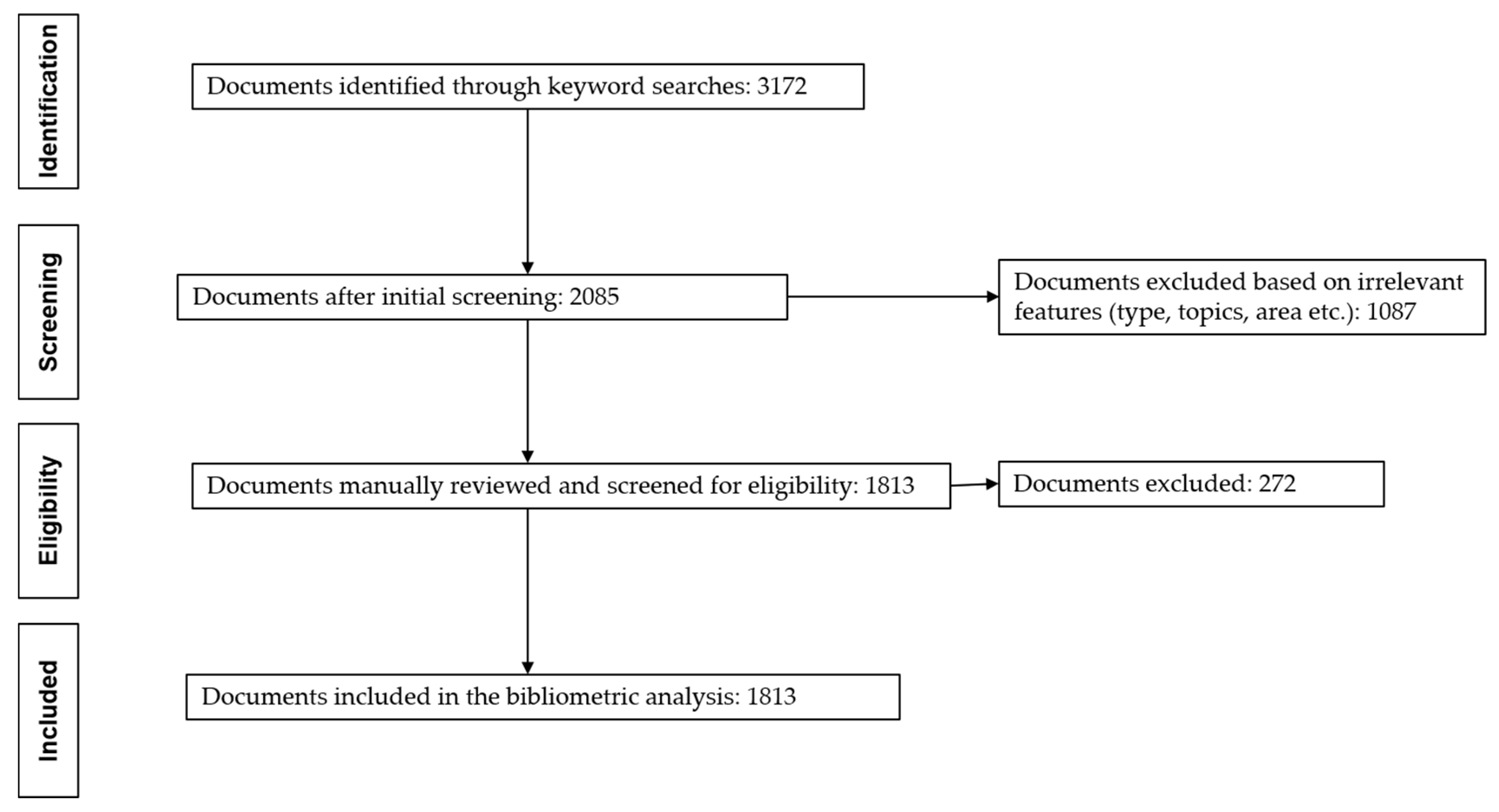


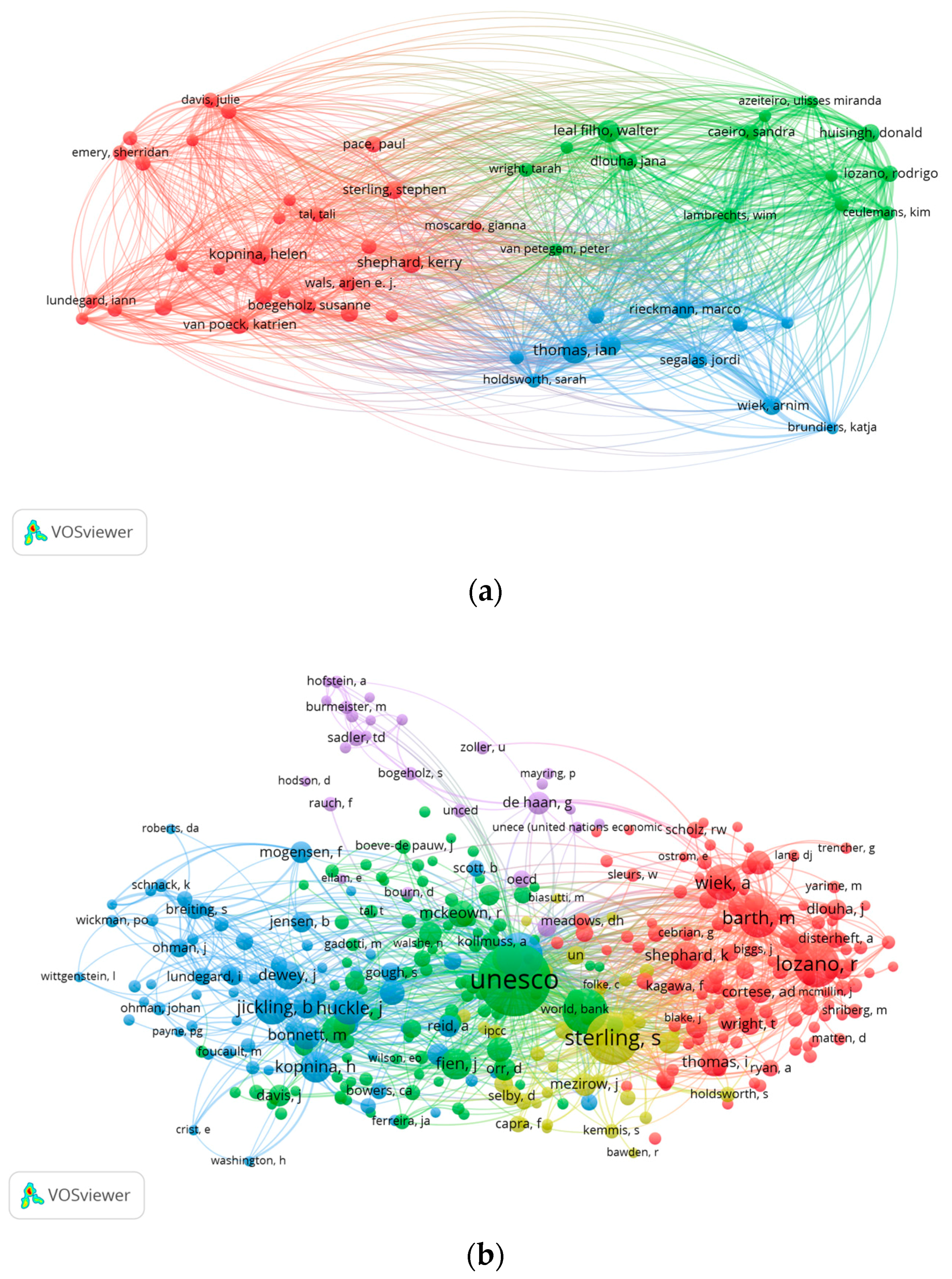


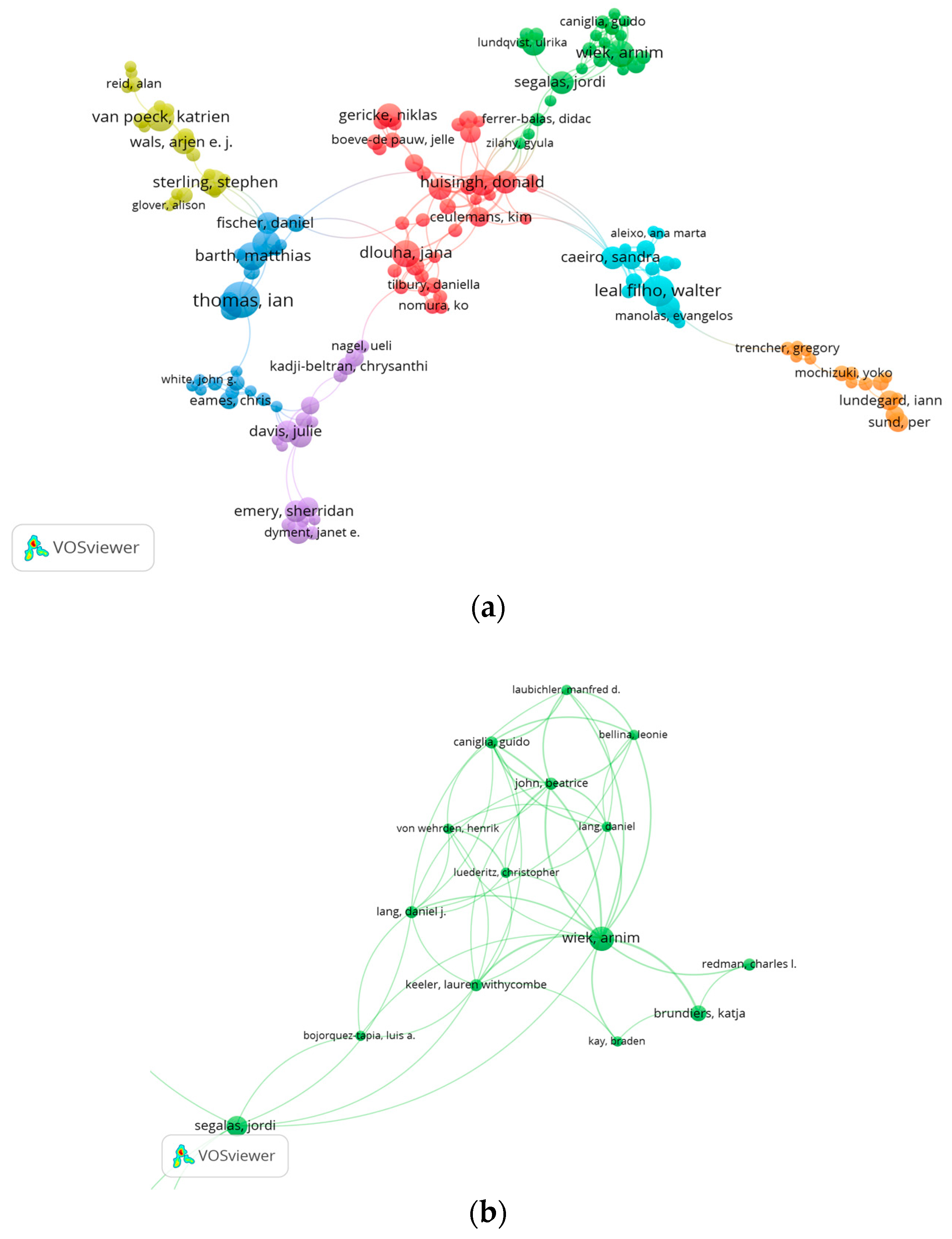
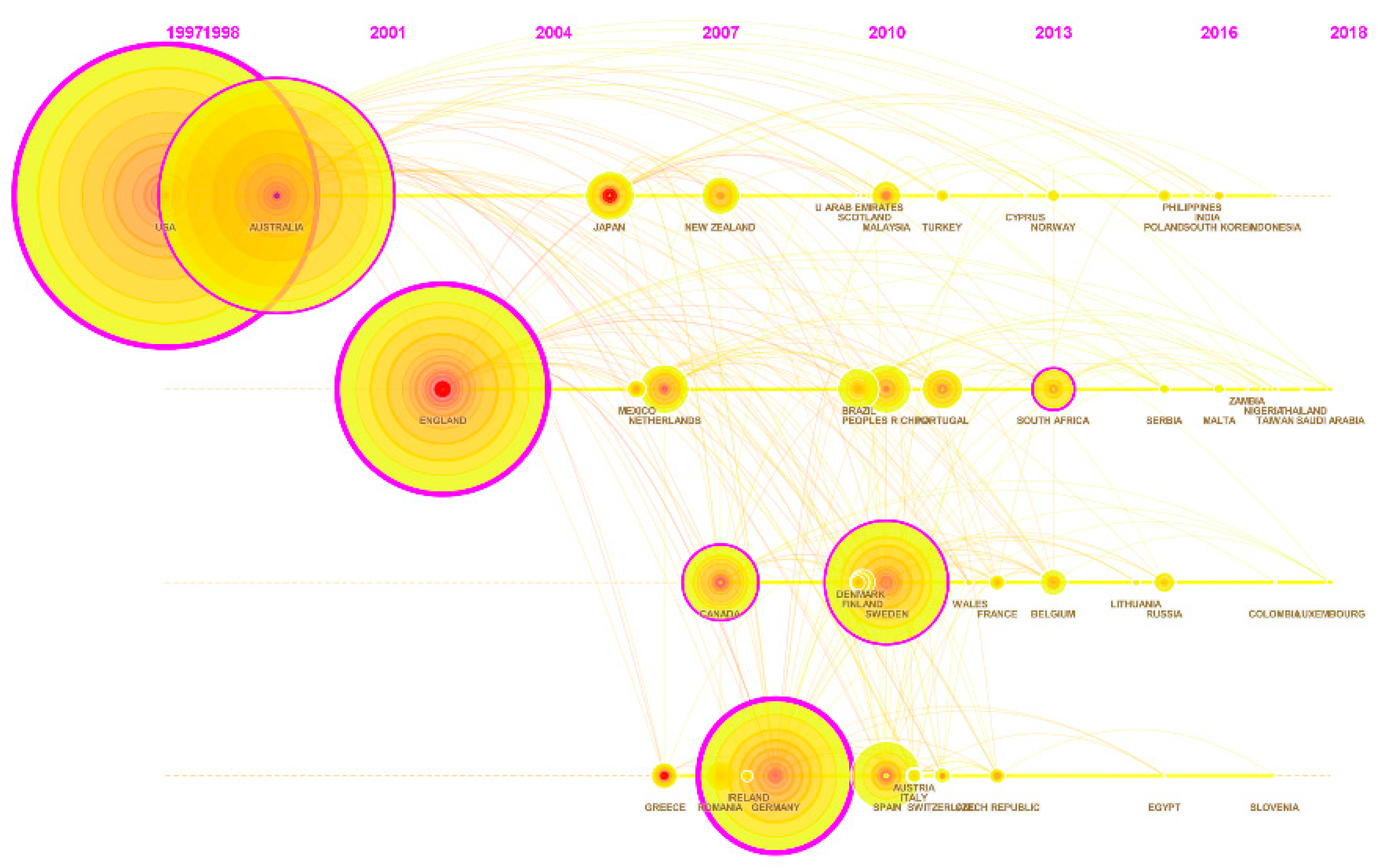
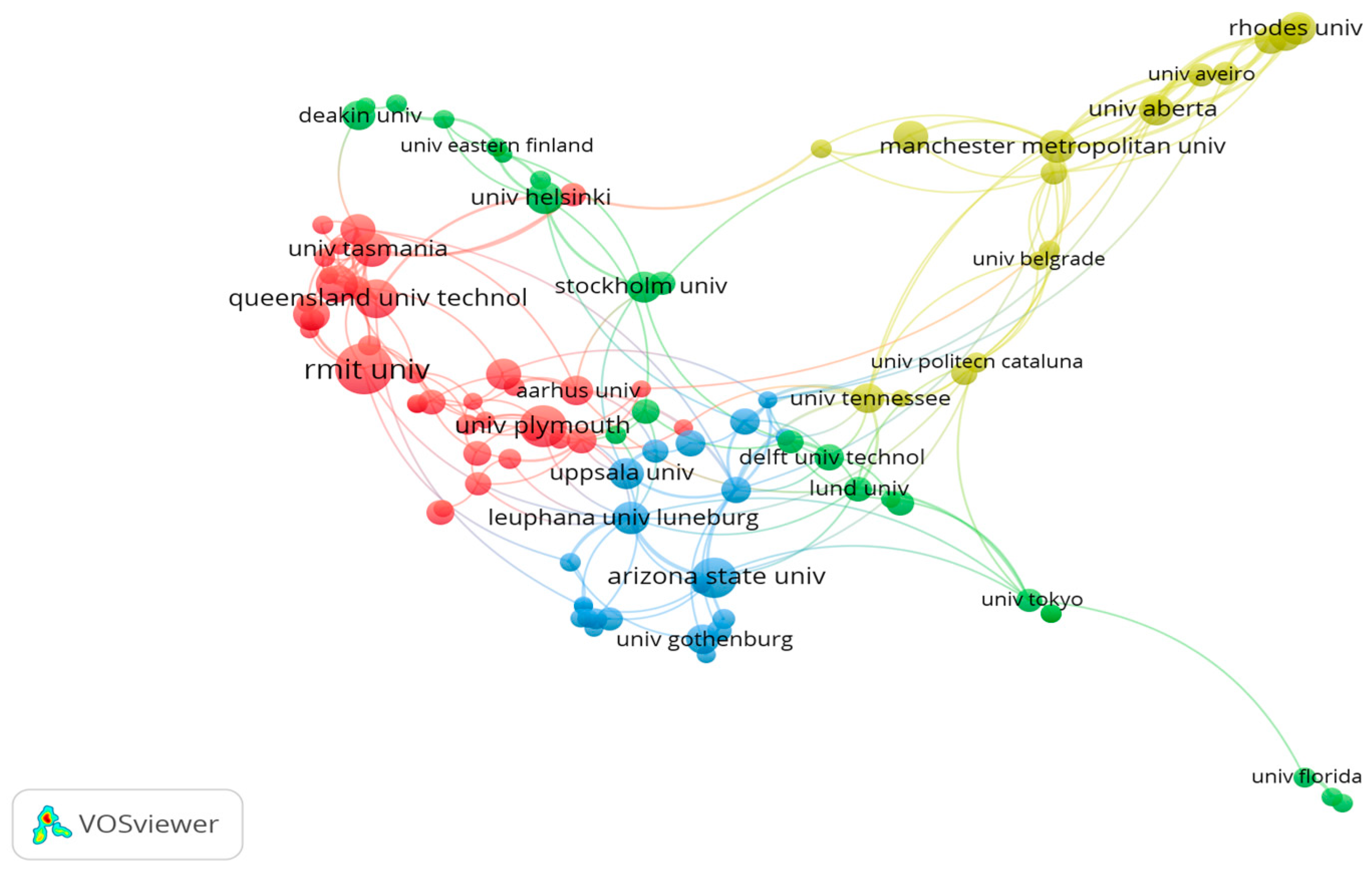
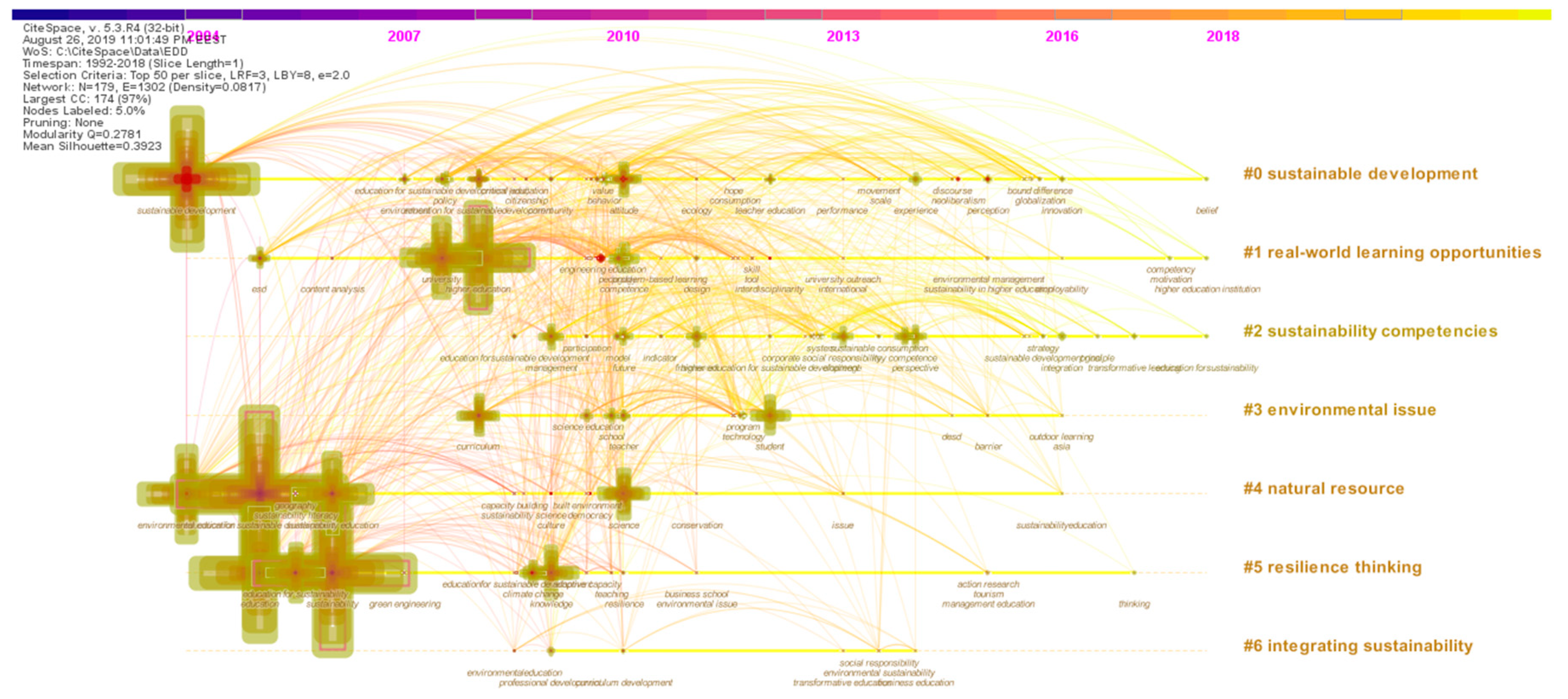
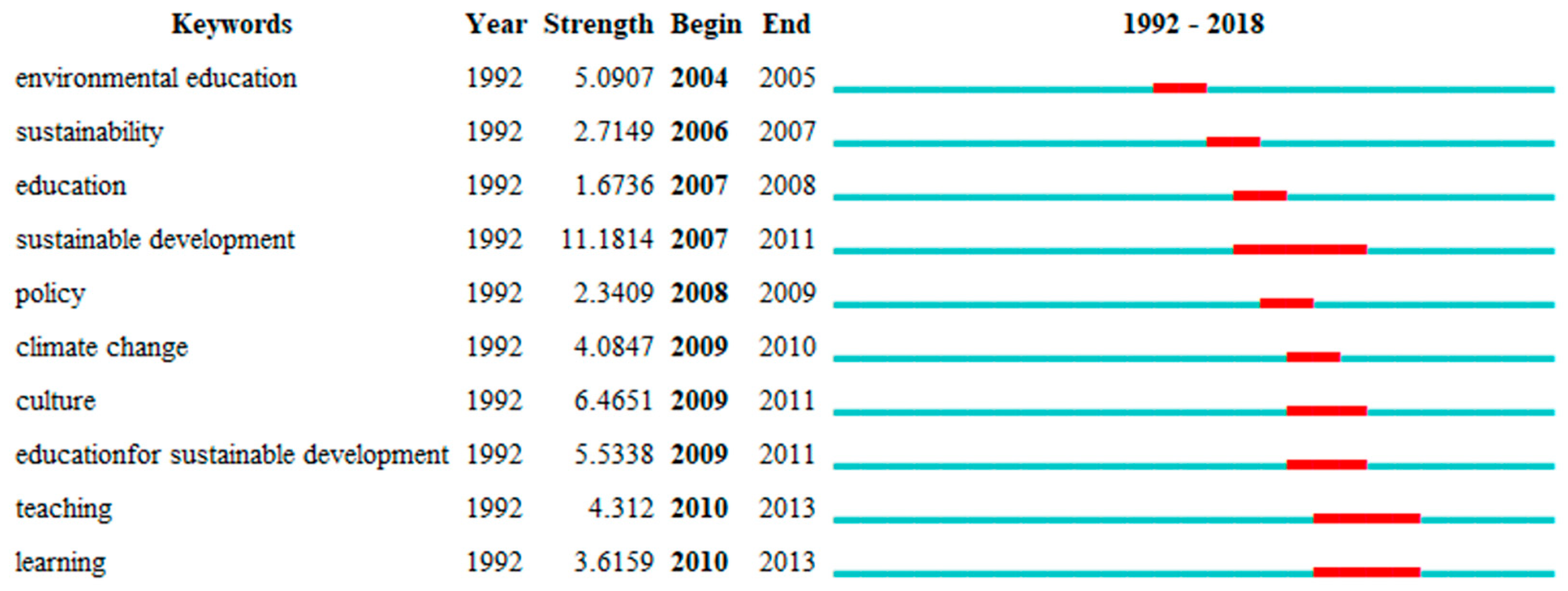
| Criteria | Details |
|---|---|
| Database | Web of Science Core Collection |
| Citation index | SCIE (Science Citation Index Expanded) and SSCI (Social Sciences Citation Index) |
| Topics | “Sustainability Education” (SE), “Education for Sustainability” (EfS), and “Education for Sustainable Development” (ESD) |
| Time span | 1992–2018 |
| Document type | Articles, books, book chapters, proceedings papers, reviews |
| Journal | IF (2018) | Quartile in WoS Category | Papers |
|---|---|---|---|
| Environmental Education Research | 2.255 | Education and Educational Research, Q1 | 173 |
| Environmental Studies, Q3 | |||
| International Journal of Sustainability in Higher Education | 1.437 | Education and Educational Research, Q3 | 144 |
| Green and Sustainable Science and Technology, Q4 | |||
| Journal of Cleaner Production | 6.395 | Engineering, Environmental, Q1 | 120 |
| Environmental Sciences, Q1 | |||
| Green and Sustainable Science and Technology, Q1 | |||
| Sustainability | 2.592 | Environmental Sciences, Q2 | 94 |
| Environmental Studies, Q2 | |||
| Green and Sustainable Science and Technology, Q2 | |||
| Australian Journal of Environmental Education | - | - | 32 |
| Journal of Environmental Education | 2.04 | Education and Educational Research, Q1 | 32 |
| Environmental Studies, Q3 | |||
| Journal of Geography in Higher Education | 1.533 | Education and Educational Research, Q2 | 20 |
| Geography, Q3 | |||
| Sustainability Science | 4.669 | Environmental Sciences, Q1 | 16 |
| Green and Sustainable Science and Technology, Q2 | |||
| Journal of Professional Issues in Engineering Education and Practice | 1.372 | Education, Scientific Disciplines, Q3 | 15 |
| Engineering, Multidisciplinary, Q3 | |||
| Research in Science Education | 1.382 | Education and Educational Research, Q3 | 14 |
| Author | WoS | Scopus | Google Scholar | ||||||
|---|---|---|---|---|---|---|---|---|---|
| h | Documents | Citations | h | Documents | Citations | h | Documents | Citations | |
| Wiek, A | 31 | 11 | 680 | 35 | 100 | 5304 | 44 | 146 | 10,163 |
| Huisingh, D | 35 | 10 | 632 | 37 | 112 | 4099 | NA * | ||
| Lozano, R | 29 | 8 | 624 | 30 | 64 | 3795 | 37 | 138 | 7388 |
| Redman, CL | 35 | 3 | 546 | 25 | 156 | 2464 | 49 | 197 | 20,355 |
| Lambrechts, W | 9 | 7 | 435 | 9 | 16 | 709 | 12 | 100 | 1531 |
| Lozano, FJ | 10 | 4 | 411 | 37 | 250 | 4530 | 13 | 36 | 1869 |
| Lukman, R | 11 | 4 | 385 | 11 | 16 | 1101 | NA * | ||
| Withycombe, L | 2 | 1 | 376 | 7 | 14 | 622 | 10 | 17 | 1397 |
| Rieckmann, M | 9 | 11 | 370 | 8 | 19 | 650 | 18 | 154 | 2322 |
| Wals, AEJ | 23 | 8 | 352 | 24 | 94 | 2078 | 46 | 510 | 9101 |
| Title | Authors | Journal | Year | Citations | AN/IN/CN |
|---|---|---|---|---|---|
| Key competencies in sustainability: a reference framework for academic program development | Wiek, A.; Withycombe, L.; Redman, CL | Sustainability Science | 2011 | 377 | 3/1/2001 |
| Declarations for sustainability in higher education: becoming better leaders, through addressing the university system | Lozano, R et al. | Journal of Cleaner Production | 2013 | 219 | 5/5/2005 |
| Ethics, CSR, and sustainability education in the Financial times top 50 global business schools: Baseline data and future research directions | Christensen, LJ; et al. | Journal of Business Ethics | 2007 | 193 | 5/3/2001 |
| Globalization and environmental education: looking beyond sustainable development | Jickling, B. Wals, AEJ | Journal of Curriculum Studies | 2008 | 168 | 2/1/2001 |
| Real-world learning opportunities in sustainability: from classroom into the real world | Brundiers, K.; Wiek, A. Redman, CL | International Journal of Sustainability in HE | 2010 | 136 | 3/1/2001 |
| Future-oriented higher education: Which key competencies should be fostered through university teaching and learning? | Rieckmann, M. | Futures | 2012 | 125 | 1/1/2001 |
| Higher education for sustainability by means of transdisciplinary case studies: an innovative approach for solving complex, real-world problems | Steiner, G.; Posch, A. | Journal of Cleaner Production | 2006 | 123 | 2/1/2001 |
| A review of commitment and implementation of sustainable development in higher education: results from a worldwide survey | Lozano, R. et al. | Journal of Cleaner Production | 2015 | 105 | 9/8/2007 |
| The action competence approach and the ‘new’ discourses of education for sustainable development, competence and quality criteria | Mogensen, F.; Schnack, K. | Environmental Education Research | 2010 | 96 | 2/2/2001 |
| Academic staff development as a catalyst for curriculum change towards education for sustainable development: an output perspective | Barth, M.; Rieckmann, M. | Journal of Cleaner Production | 2012 | 90 | 2/2/2002 |
| Cited Reference | Citations |
|---|---|
| Wiek A, Withycombe L, Redman CL. Key competencies in sustainability: a reference framework for academic program development. Sustainability Science. 2011 1;6(2):203–218. | 127 |
| UNESCO. UN Decade of Education for Sustainable Development. Links between the global initiatives in education. 2005 | 90 |
| Cortese AD. The critical role of higher education in creating a sustainable future. Planning for Higher Education. 2003 Mar 15;31(3):15–22. | 82 |
| Lozano R. Incorporation and institutionalization of SD into universities: breaking through barriers to change. Journal of Cleaner Production. 2006 1;14(9–11):787–96. | 77 |
| Jickling B, Wals AE. Globalization and environmental education: Looking beyond sustainable development. Journal of Curriculum Studies. 2008 1;40(1):1–21. | 72 |
| Barth M, Godemann J, Rieckmann M, Stoltenberg U. Developing key competencies for sustainable development in higher education. International Journal of Sustainability in Higher Education. 2007; 8(4): 416–430. | 71 |
| Lozano R, Lukman R, Lozano FJ, Huisingh D, Lambrechts W. Declarations for sustainability in higher education: becoming better leaders, through addressing the university system. Journal of Cleaner Production. 2013 1;48:10–9. | 70 |
| Sipos Y, Battisti B, Grimm K. Achieving transformative sustainability learning: engaging head, hands and heart. International Journal of Sustainability in Higher Education. 2008; 9(1):68–86. | 69 |
| Wals A, Jickling B. “Sustainability” in higher education: From doublethink and newspeak to critical thinking and meaningful learning. International Journal of Sustainability in Higher Education. 2002; 3: 221–232. | 62 |
| World Commission on Environment and Development (WCED). Our Common Future. Oxford University Press. 1987. | 59 |
© 2019 by the authors. Licensee MDPI, Basel, Switzerland. This article is an open access article distributed under the terms and conditions of the Creative Commons Attribution (CC BY) license (http://creativecommons.org/licenses/by/4.0/).
Share and Cite
Grosseck, G.; Țîru, L.G.; Bran, R.A. Education for Sustainable Development: Evolution and Perspectives: A Bibliometric Review of Research, 1992–2018. Sustainability 2019, 11, 6136. https://doi.org/10.3390/su11216136
Grosseck G, Țîru LG, Bran RA. Education for Sustainable Development: Evolution and Perspectives: A Bibliometric Review of Research, 1992–2018. Sustainability. 2019; 11(21):6136. https://doi.org/10.3390/su11216136
Chicago/Turabian StyleGrosseck, Gabriela, Laurențiu Gabriel Țîru, and Ramona Alice Bran. 2019. "Education for Sustainable Development: Evolution and Perspectives: A Bibliometric Review of Research, 1992–2018" Sustainability 11, no. 21: 6136. https://doi.org/10.3390/su11216136
APA StyleGrosseck, G., Țîru, L. G., & Bran, R. A. (2019). Education for Sustainable Development: Evolution and Perspectives: A Bibliometric Review of Research, 1992–2018. Sustainability, 11(21), 6136. https://doi.org/10.3390/su11216136





